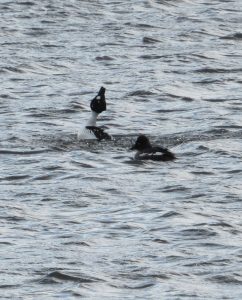Bird-watching is one of the most popular activities at Lakeshore State Park, and it can be done in lots of different ways.
Whether you’ve got binoculars or an iPhone, you’re on your lunch break or making a special trip, it’s a rewarding and relaxing experience.
Blogger and birder Nathaniel Wegner shared some of his tips about birding at LSP, where a combination of lakeshore and prairie habitats create great bird-watching opportunities year-round. And check out Sunday Birders, Nathaniel’s blog about birding and exploring nature throughout Wisconsin.
1. Spring migration is a great time to view visiting species.
March through June is the peak of spring migration season, when you can spot species that are just passing through. This is when you can see unique shorebird species like the American Avocet (one of Nathaniel’s favorites) and Hudsonian and Marbled Godwits in addition to the more common Willets.
“Certain days each May can be amazing, especially with winds from the southwest, which push the birds towards the lake.”
Nathaniel Wegner
Birders have observed over 100 species in a single day during this time of year. Nathaniel’s tip: Always check the beach for the shorebirds and any terns that are migrating through.
2. Fall migration is, too!
Humans may pack up their beach towels when fall comes, but shorebirds come back again.. “This is also the time when rarities such as Whimbrel, Buff-breasted Sandpiper, and Nelson’s and LeConte’s Sparrows have shown up,” said Nathaniel.

In addition to the beach, don’t overlook the large grassy area in the middle of the park, said Nathaniel. “It’s a good spot to check in fall, as a few of the shorebird species have been seen there, and sometimes a Cackling Goose will show up, too.”
3. Check out the rain garden area in summer.
“Summer is the quietest season in terms of birding in Milwaukee, but the rain garden area could have species like Sora or a Green Heron lurking in the reeds.”
4. The lakeshore rocks see action in cold months.
Starting in late October through January, the rocks along the lake are a great place to look for late migrants, said Nathaniel. These include Snow Bunting, Horned Lark and American Pipit, which sometimes will even winter in the area. You might even find a Short-eared Owl.
5. Visit the lagoon in winter
In the winter months, the lagoon is the place to spot many species of diving ducks, especially Long-tailed Ducks and scoter species.
6. Give eBird a try!
Nathaniel recommends that anyone interested in birds try eBird, a website and app from the Cornell University Lab of Ornithology. “You can keep track of all the species you’ve seen, get rare bird alerts, see what species are usually seen at a specific park, and help science along the way.”











